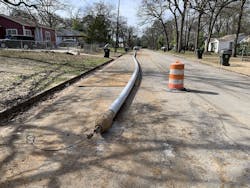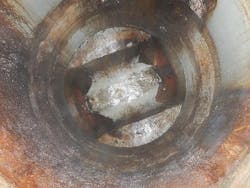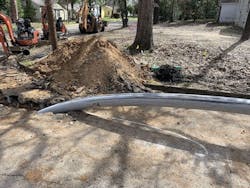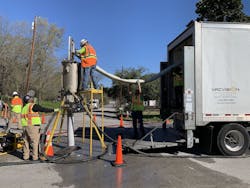Saving a City, One Manhole at a Time
About the author:
Chase Chandler is an EIT at Lockwood, Andrews & Newnam, Inc, (LAN), a national planning, engineering and program management firm. He can be reached at [email protected].
In 2017, the Environmental Protection Agency (EPA) finalized a 10-year consent decree with the city of Tyler. The consent decree requires Tyler Water Utilities to develop and implement a capacity, management, operation and maintenance program for the city’s wastewater system to reduce sanitary sewer system overflows.
Following a comprehensive condition assessment and prioritization analysis, the city hired Lockwood, Andrews & Newnam Inc. (LAN), a national, planning, engineering, and program management firm, to provide engineering services for Group 1 of the consent decree. Other sub-consultant firms that partnered with LAN included Garver, who provided design support for two construction packages, and Adams Engineers & Development Consultants, who provided field support throughout the work and design support for one package. Adams Engineers also provided construction inspection for all packages.
The 10-year consent decree required the condition assessment and rehabilitation of 690 miles of sewer mains and 11,000 manholes in the city’s sewer system. Group 1 work included the rehabilitation or replacement of approximately 900 manholes and more than 40,000 linear feet of wastewater mains. The proposed rehabilitation methods included:
- Manhole Rehabilitation: 897
- Cured-In-Place-Pipe (CIPP) Rehabilitation: 5,787 linear feet
- Pipe Bursting Rehabilitation: 35,752 linear feet
- Open Cut Replacement: 4,583 linear feet
- Point Repairs: 164 (14,690 +/- linear feet of pipe)
When design started in fall 2018, the biggest challenge was completing construction of the improvements by December 2020. To achieve this goal, LAN implemented the following creative strategies.
Project Bundling
To minimize contractor markup, LAN used a combination of geography and construction technology to create attractive work packages for bidding. If a project is too small, the bidding will be less competitive, typically leading to higher prices. If packages are too large, then the schedule is more dependent on the performance of the contractor to complete the work on time and it can limit the number of potential bidders.
In response, the project team bundled the gravity main rehabilitation by rehabilitation technology or method. Two separate factors led to this decision: location and bidding. Since the pipeline rehabilitation work was limited to two sewer-shed basins, all improvements were relatively close to each other and mobilizing between construction sites prevented massive delays. This allowed the city to minimize the need for a general contractor to subcontract specialized parts of the work (e.g. a technology not performed in-house), resulting in more competitive pricing and a streamlined delivery schedule. Based on these factors, separate construction packages were developed for CIPP, pipe bursting, open cut replacement, and point repairs.
Manhole rehabilitation is typically performed by a single contractor with little need to subcontract specialized tasks. For this project, manhole improvements were scattered throughout the city rather than being isolated to two basins, so the work was split based on geography. Packaging the manhole rehabilitation by the east and west sides of the city saved money by allowing the contractors to work locally and reduce remobilization costs. The primary rehabilitation recommendation was installation of a geopolymer mortar coating, although some manholes required additional miscellaneous repairs such as frame and cover replacement, invert rebuilding, or inflow protector installation.
GIS-Based Design
Typically, for rehabilitation work, contractors only need to know where the work is and what to do, essentially requiring only a map and technical specifications rather than detailed plan and profile drawings. The large amount of assets in Group 1 meant that a traditional design process would be inefficient for this project, jeopardizing the schedule. To solve this problem, rehabilitation tables were included under each plan view of proposed improvements.
LAN produced the plan sets for each rehabilitation package using GIS information provided by the city. Each plan sheet showed an aerial view of the project area (at a 1 inch = 200 feet scale) with tables to show the assets being rehabilitated. The tables included the city-designated asset ID and other relevant information such as manhole depth, manhole diameter, pipe length, pipe material, and type of rehabilitation or replacement required.
Plan sheets did not include profile views as the plan view and table information was sufficient for contractors to identify location, estimate quantities, and perform rehabilitation or replacement of existing infrastructure. This format allowed the city to get to the construction phase quicker and thus minimize the risk of construction delays impacting the cecree timeline.
GIS-Based Design Benefits
A critical requirement of the consent decree is reporting the work performed to the EPA. This reporting, which is typically provided annually, shows the EPA that the planned rehabilitation has been performed. Using a GIS-based system allows a table to be easily generated from the record information to be included in the consent decree annual report, thus adding value to the client by decreasing manual record keeping and improving accuracy.
An additional benefit of using GIS as the basis for plan sheet development is the seamless integration with the city’s asset management system. At the completion of each work package, LAN provided data that the city was quickly able to update to its asset management software.
Additionally, using GIS for plan production allowed plans to be easily updated with new information as it became available. For example, when location information is corrected with data from cleaning or CCTV programs, the plans were easily updated and provided to city staff and contractors. This allowed for a living document that minimized unnecessary back and forth and provided a universal reference for all involved with the project.
Bidding Strategies
To expedite the project schedule, LAN considered different methods of procuring the work and staggered bidding so that packages with longer construction times started earlier. Different delivery methods offer different benefits, so it is important to make the decision based on the project’s end goals.
In addition to the standard design-bid-build process, LAN and the city utilized Texas BuyBoard for two of the construction packages. The Texas BuyBoard is a purchasing cooperative that cities can use to purchase goods and services that have already been competitively bid according to the state’s statutory procurement process. Purchasing cooperatives typically have an extensive list of items to cover a wide variety of project needs. Using BuyBoard allowed the city to request pricing from contractors, compare bids, and choose the contractor of its choice. This method helped the city to achieve its objective of reducing the timeline from design to construction, thus minimizing construction schedule risk.
For the remaining packages, LAN and the city used a standard design-bid-build approach. Staggering the packages according to the anticipated construction schedule reduced the review burden on city staff, since the design milestones were not stacked on top of each other. Anticipating that the two manhole packages would have the longest schedule, the city bid those packages first, followed by the CIPP package, pipe bursting package, and point repair package.
Current Status
To date, the city has rehabilitated more than 900 manholes, over 41,000 linear feet of pipe and performed 230 point repairs under budget and on schedule. Of the completed work, three packages, including record drawings and GIS database updates, have been provided to the city and are closed out in full. Using many of the successful strategies implemented for Group 1, in late 2019, the city began work on Group 2 of the consent decree, which involves rehabilitation of 27,000 linear feet of sewer main, 570 point repairs and more than 600 manholes.
“LAN, working with Garver and Adams, partnered with the city to focus on the needs of the citizens of Tyler,” said Paul Neuhaus, M.S., P.E., city of Tyler environmental compliance engineer. “Remediation work in a collection system, identified by a relatively new and maturing asset management system, will inevitably lead to the discovery of conflicts and unforeseen field conditions. This requires prompt and diligent action to develop a cost-effective and acceptable solution that satisfies the needs of stakeholders. Group 1 of the consent decree remediation work had no shortage of such challenges, but they appear to have been met and dealt with head-on.”



